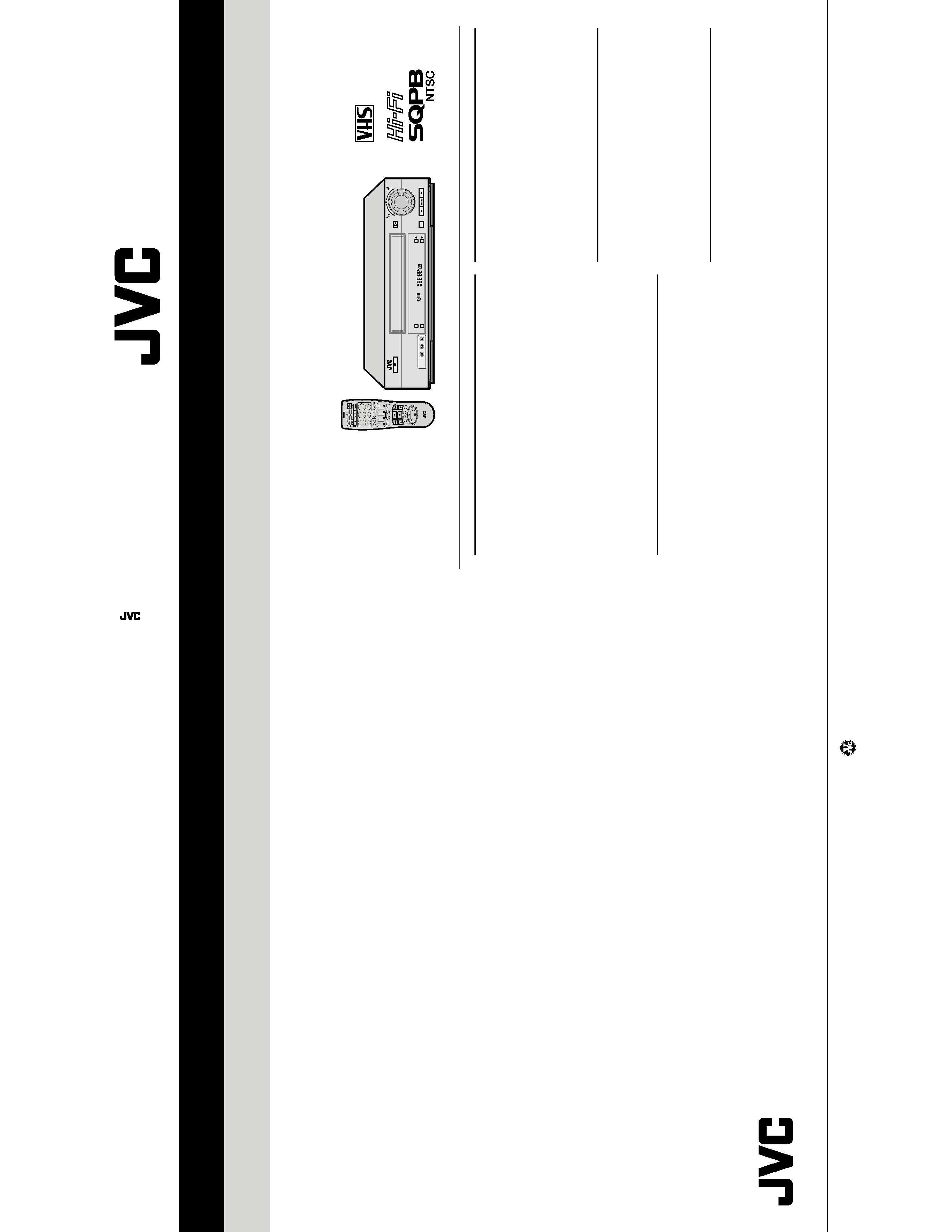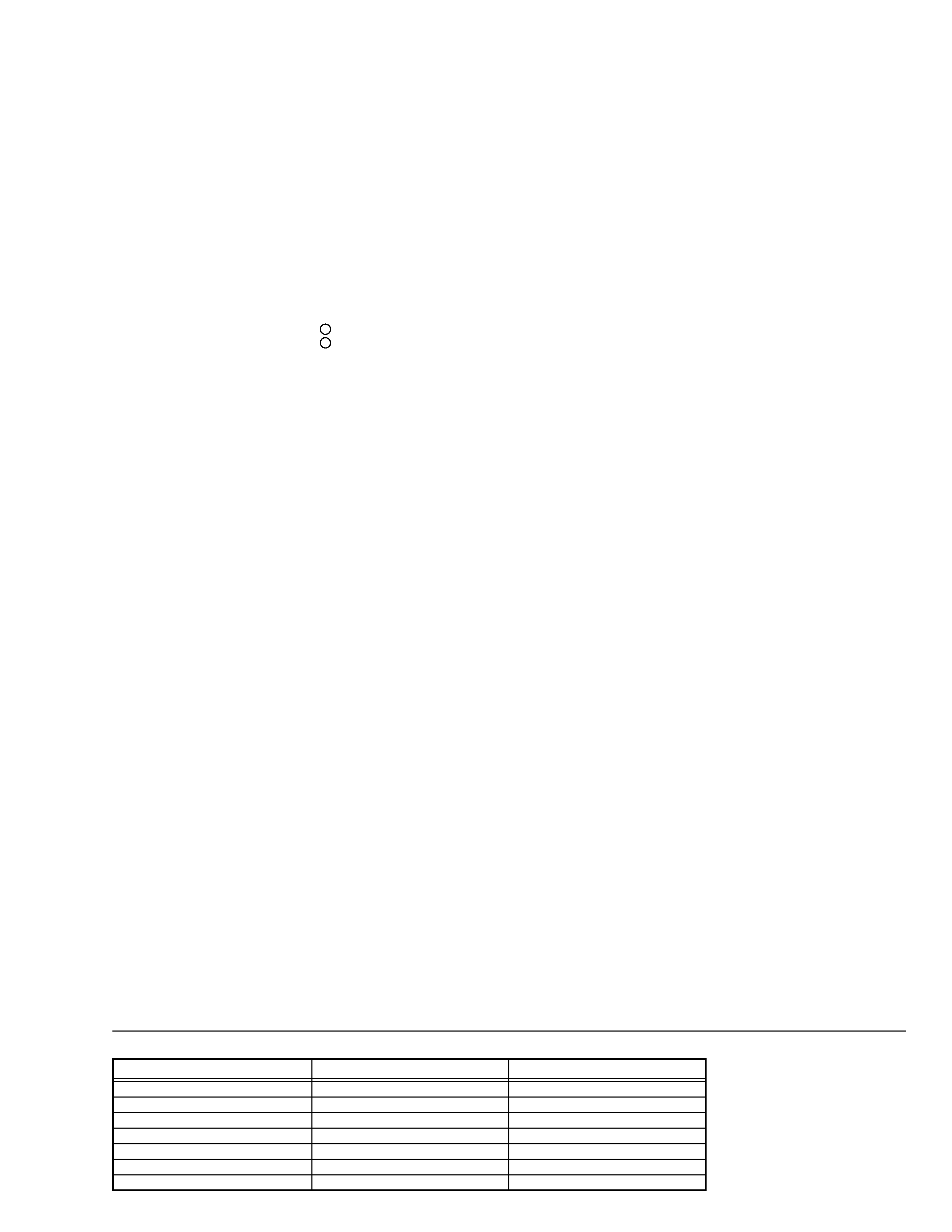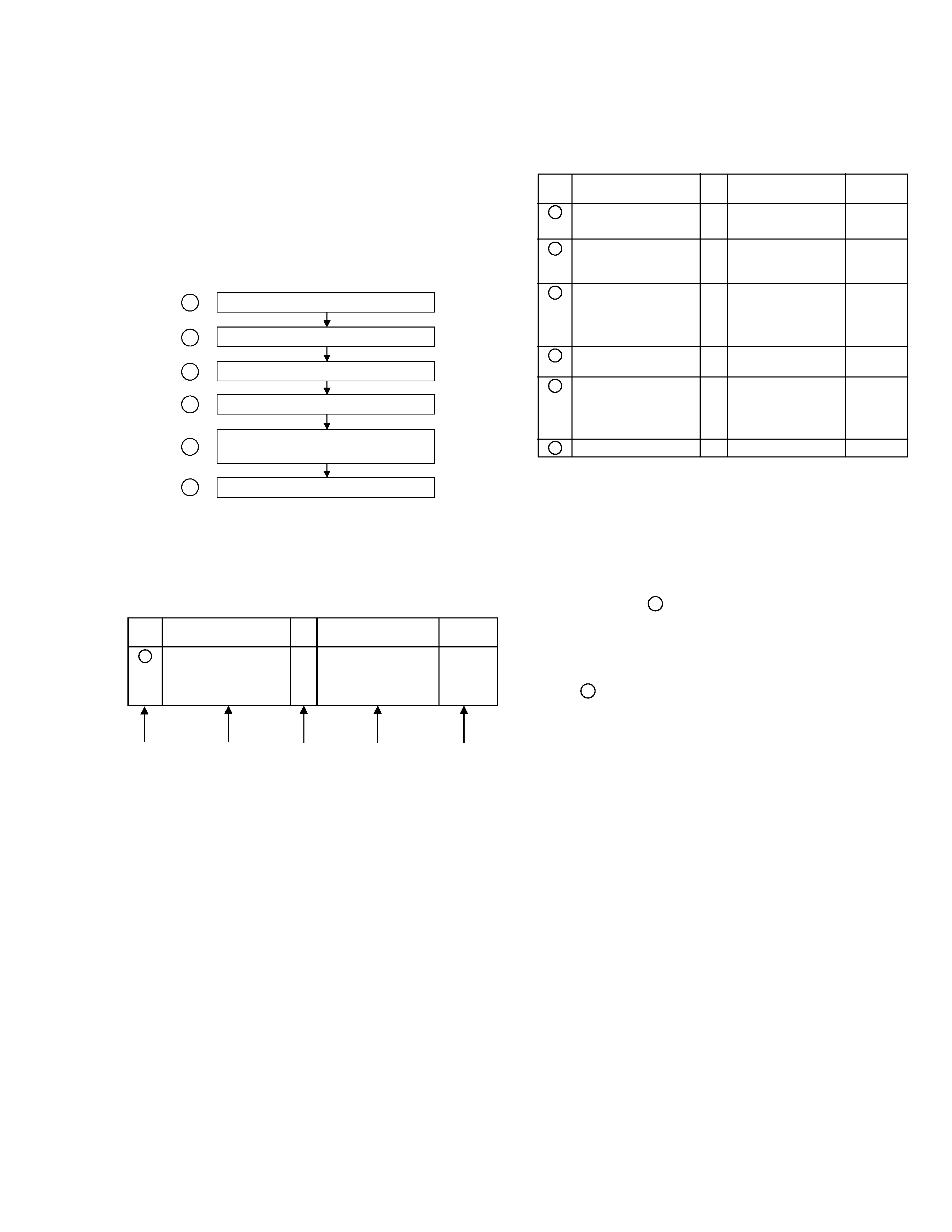
SERVICE MANUAL
No. 82785
July 2000
HR-J686EN/J686M
ESPECIFICACIONES (The specifications shown pertain specifically to the model HR-J686EN)
VIDEO CASSETTE RECORDER
Printed in Japan
VICTOR COMPANY OF JAPAN, LIMITED
VIDEO DIVISION
S40894
This service manual is printed on 100% recycled paper.
COPYRIGHT © 2000 VICTOR COMPANY OF JAPAN, LTD.
HR-J686EN/J686M
No.
82785
VIDEO (MONO)L--AUDIO--R
SP/LP
CH
OK
FF
REW
POWER
SP
EP
VCR
REC
PAUSE
STOP/EJECT
PLAY
MENU
N-PAL NTSC
TV PROG +
T
V
TV PROG
TV
+
VCR
START
DEBUT
STOP
FIN
DATE
MENU
OK
TV
PROG
TV/VCR
0000
DAILY/QTDN.
AUX
WEEKLY/HEBDO
PROG
AUDIO
CABLE
/SAT
123
45
6
7
89
0
2
4
1
3
EXPRESS
PQ000000
TV
VPS/PDC
ENTER/ENTREE
30 SEC
mULTImARQUE
GENERALIDADES
Alimentación
: 110 V 220 V` - CA, 50/60 Hz
Consumo
Alimentación conectada
: 19 W
Alimentación desconectada : 2,5 W
Temperatura
De funcionamiento : 5°C a 40°C (41°F a 104°F)
De almacenamiento : 20°C a 60°C (4°F a140°F)
Posición de funcionamiento : Unicamente horizontal
Dimensiones (An x Al x Pr) : 400 mm x 94 mm x 281 mm
Peso
: 3,5 kg
Formato
: Norma VHS PAL-N/NTSC
Tiempo máximo de grabación
SP
: 240 minutos con un videocassette E-240 (PAL-N)
: 160 minutos con un videocassette T-160 (NTSC)
LP
: 480 minutos con un videocassette E-240 (PAL-N)
EP
: 480 minutos con un videocassette T-160 (NTSC)
VIDEO/AUDIO
Sistema de señales
: Señal de color tipo PAL-N y señales monocromas
EIA, 625 líneas/50 campos, Señales cromáticas
NTSC y señales monocromas EIA, 525 líneas /60
campos (solo para reproducción)
Sistema de grabación/
reproducción
: Sistema de exploración helicoidal de 4 cabezas
DA-4 (doble acimut)
Relación señal a ruido
: 45 dB
Resolución horizontal
: 240 líneas (PAL-N)
: 230 líneas (NTSC)
Gama de frequencia
Audio nomal
: 70 Hz a 10,000 Hz
Audio de alta
fidelida
: 20 Hz a 20,000 Hz
Entrada/Salida
: Conectores RCA (IN x 1, OUT x 1)
SINTONIZADOR
Sistema de sintonía
: Sintonizador de frecuencia
sintetizada
Cobertura de canales
VHF
: Canales 213
UHF
: Canales 1469
CATV
: 113 Canales
Salida de RF
: Salida de RF: Canal 3 ó 4
(conmutable; preajustado en fábrica
al canal 3) 75
,
asimétrica
TEMPORIZADOR
Referencia de reloj
: Cuarzo
Capacidad de
programación
: Temporizador programable para 1
año/8 programas
Tiempo de protección
de la memoria
: Aprox. 6 meses
Cifra estimada pasada en la
pila nueva suministrada; el
rendimiento real puede ser diferente.
ACCESORIOS
Accesorios suministrados
: Cable RF,
Unidad e control remoto por
infrarrojos,
Pila de litio CR2025,
Pila "AA" x 2
A menos que se especifique lo contrario, las especificaciones dadas son
para el modo SP.
El diseño y las especificaciones se encuentran sujetos a cambios sin previo
aviso.

Important Safety Precautions
INSTRUCTIONS
1. DISASSEMBLY
1.1 DISASSEMBLY FLOW CHART ............................................ 1-1
1.2 HOW TO READ THE DISASSEMBLY AND ASSEMBLY ...... 1-1
1.3 DISASSEMBLY/ASSEMBLY METHOD ................................ 1-1
1.4 SERVICE POSITION ............................................................ 1-4
1.4.1 How to take out the Mechanism and Main board
assemblies ....................................................................... 1-4
1.5 MECHANISM SERVICE MODE ............................................ 1-5
1.5.1 How to set the "MECHANISM SERVICE MODE" ............ 1-5
1.6 EMERGENCY DISPLAY FUNCTION ................................... 1-6
1.6.1 Displaying the emergency information ............................. 1-6
1.6.2 Clearing the emergency history ....................................... 1-6
1.6.3 Emergency content description........................................ 1-7
1.6.4 Emergency detail information 1 ...................................... 1-8
1.6.5 Emergency detail information 2 ...................................... 1-9
1.7 SYSCON CIRCUIT ............................................................. 1-10
1.7.1 Syscon CPU pin function (IC3001) ................................ 1-10
2. MECHANISM ADJUSTMENT
2.1 BEFORE STARTING REPAIR AND ADJUSTMENT ............. 2-1
2.1.1 Precautions ...................................................................... 2-1
2.1.2 Checking for Proper Mechanical Operations ................... 2-1
2.1.3 Manually Removing the Cassette Tape ........................... 2-1
2.1.4 Jigs and Tools Required for Adjustment ........................... 2-2
2.1.5 Maintenance and Inspection ............................................ 2-3
2.2 REPLACEMENT OF MAJOR PARTS ................................... 2-6
2.2.1 Before Starting Disassembling (Phase matching between
mechanical parts) ............................................................. 2-6
2.2.2 How to Set the Mechanism Assembling Mode ................. 2-6
2.2.3 Cassette Holder Assembly ............................................... 2-6
2.2.4 Pinch Roller Arm Assembly .............................................. 2-8
2.2.5 Guide Arm Assembly and Press Lever Assembly ............ 2-8
2.2.6 Audio Control Head.......................................................... 2-8
2.2.7 Loading Motor .................................................................. 2-8
2.2.8 Capstan Motor ................................................................. 2-9
2.2.9 Pole Base Assembly (supply or take-up side) .................. 2-9
2.2.10 Rotary Encoder ............................................................ 2-10
2.2.11 Clutch Unit ................................................................... 2-10
2.2.12 Change Lever Assembly, Direct Gear, Clutch Gear and
Coupling Gear .............................................................. 2-10
2.2.13 Link Lever ..................................................................... 2-11
2.2.14 Cassette Gear, Control Cam and Worm Gear .............. 2-11
2.2.15 Control Plate ................................................................. 2-11
2.2.16 Loading Arm Gear (supply or take-up side) and
Loading Arm Gear Shaft .............................................. 2-12
2.2.17 Take-up Lever, Take-up Head and Control Plate Guide 2-13
2.2.18 Capstan Brake Assembly ............................................. 2-13
2.2.19 Sub Brake Assembly (take-up side) ............................. 2-13
2.2.20 Main Brake Assembly (take-up side), Reel Disk (take-up side)
and Main Brake Assembly (supply side) .................................. 2-13
2.2.21 Tension Brake Assembly, Reel Disk (supply side) and
Tension Arm Assembly ................................................. 2-14
2.2.22 Idler Lever, Idler Arm Assembly ................................... 2-14
2.2.23 Stator Assembly ........................................................... 2-14
2.2.24 Rotor Assembly ........................................................... 2-14
2.2.25 Upper Drum Assembly ................................................. 2-15
2.3 COMPATIBILITY ADJUSTMENT ........................................ 2-16
2.3.1 Checking/Adjustment of FM Waveform Linearity ........... 2-16
2.3.2 Checking/Adjustment of the Height and Tilt of the Audio
Control Head .................................................................. 2-17
2.3.3 Checking/Adjustment of the Audio Control Head Phase
(X-Value) ........................................................................ 2-17
2.3.4 Checking/Adjustment of the Standard Tracking Preset . 2-18
2.3.5 Checking/Adjustment of the Tension Pole Position ........ 2-18
TABLE OF CONTENTS
Section
Title
Page
Section
Title
Page
3. ELECTRICAL ADJUSTMENT
3.1 PRECAUTION ...................................................................... 3-1
3.1.1 Required test equipments ................................................ 3-1
3.1.2 Required adjustment tools ............................................... 3-1
3.1.3 Color (colour) bar signal,Color (colour) bar pattern ......... 3-1
3.1.4 Switch settings and standard precautions ....................... 3-1
3.1.5 EVR Adjustment ............................................................... 3-1
3.2 SERVO CIRCUIT .................................................................. 3-2
3.2.1 Switching point ................................................................. 3-2
3.2.2 Slow tracking preset ......................................................... 3-2
3.3 VIDEO CIRCUIT ................................................................... 3-2
3.3.1 AUTO PICTURE initial setting ......................................... 3-2
3.4 DEMODULATOR CIRCUIT ................................................... 3-3
3.4.1 Input level ......................................................................... 3-3
3.4.2 Stereo VCO ...................................................................... 3-3
3.4.3 Stereo filter ....................................................................... 3-3
3.4.4 Separation - 1 .................................................................. 3-3
3.4.5 Separation - 2 .................................................................. 3-4
3.4.6 SAP VCO ......................................................................... 3-4
3.5 SYSCON CIRCUIT ............................................................... 3-4
3.5.1 Timer clock ....................................................................... 3-4
4. CHARTS AND DIAGRAMS
NOTES OF SCHEMATIC DIAGRAM .......................................... 4-1
CIRCUIT BOARD NOTES ........................................................... 4-2
4.1 BOARD INTERCONNECTIONS ........................................... 4-3
4.2 VIDEO/AUDIO SCHEMATIC DIAGRAMS ............................. 4-5
4.3 SYSTEM CONTROL SCHEMATIC DIAGRAM ..................... 4-7
4.4 SWITCHING REGULATOR SCHEMATIC DIAGRAM .......... 4-9
4.5 TUNER/DEMOD SCHEMATIC DIAGRAM .......................... 4-11
4.6 DISPLAY, MINI FRONT AND SHUTTLE SCHEMATIC
DIAGRAMS ......................................................................... 4-13
4.7 BS CONNECTION AND LITHIUM BATTERY
SCHEMATIC DIAGRAMS ................................................... 4-15
4.8 TERMINAL SCHEMATIC DIAGRAM .................................. 4-16
4.9 MAIN, A/C HEAD, MINI FRONT, SHUTTLE AND
LOADING MOTOR CIRCUIT BOARDS .............................. 4-17
4.10 FDP GRID ASSIGNMENT AND ANODE CONNECTION 4-21
4.11 REMOTE CONTROL SCHEMATIC DIAGRAM ................ 4-22
4.12 VOLTAGE CHARTS ......................................................... 4-23
4.13 SYSTEM CONTROL BLOCK DIAGRAM ......................... 4-25
4.14 VIDEO BLOCK DIAGRAM ................................................ 4-27
4.15 AUDIO BLOCK DIAGRAM ................................................ 4-29
5. PARTS LIST
5.1 PACKING AND ACCESSORY ASSEMBLY <M1> ............... 5-1
5.2 CABINET AND CHASSIS ASSEMBLY <M2> ...................... 5-2
5.3 MECHANISM ASSEMBLY <M4> ......................................... 5-4
5.4 ELECTRICAL PARTS LIST ................................................... 5-6
MAIN BOARD ASSEMBLY <03> ............................................... 5-6
AUDIO CONTROL HEAD BOARD ASSEMBLY <12> .............. 5-11
MINI FRONT BOARD ASSEMBLY(HR-J686M)<28> ...............5-11
LOADING MOTOR BOARD ASSEMBLY <55> ........................5-11
SHUTTLE BOARD ASSEMBLY(HR-J686EN) <85> ................ 5-12
LITHIUM BATTERY BOARD ASSEMBLY <93> ...................... 5-12
HR-J686EN
HR-J686M
SHUTTLE DIAL
NOT USED
USED
VIDEO SYSTEM
PAL-N/NTSC
PAL-M/NTSC
SQPB
NTSC ONLY
NTSC, PAL-M
LEVEL METER
USED
NOT USED
POWER PLUG
IRAM
SEV 2PIN
COSMETIC
LIGHT SILVER
CHAMPAGNE
ANT. CABLE
F-F
F-F/300ohm
The following table lists the differing points between Models (HR-J686EN and HR-J686M) in this series.

Important Safety Precautions
Prior to shipment from the factory, JVC products are strictly inspected to conform with the recognized product safety and electrical codes of the
countries in which they are to be sold. However, in order to maintain such compliance, it is equally important to implement the following precautions
when a set is being serviced.
Fig.1
1. Locations requiring special caution are denoted by labels and in-
scriptions on the cabinet, chassis and certain parts of the product.
When performing service, be sure to read and comply with these
and other cautionary notices appearing in the operation and serv-
ice manuals.
2. Parts identified by the
! symbol and shaded (
) parts are
critical for safety.
Replace only with specified part numbers.
Note: Parts in this category also include those specified to com-
ply with X-ray emission standards for products using
cathode ray tubes and those specified for compliance
with various regulations regarding spurious radiation
emission.
3. Fuse replacement caution notice.
Caution for continued protection against fire hazard.
Replace only with same type and rated fuse(s) as specified.
4. Use specified internal wiring. Note especially:
1) Wires covered with PVC tubing
2) Double insulated wires
3) High voltage leads
5. Use specified insulating materials for hazardous live parts. Note
especially:
1) Insulation Tape
3) Spacers
5) Barrier
2) PVC tubing
4) Insulation sheets for transistors
6. When replacing AC primary side components (transformers, power
cords, noise blocking capacitors, etc.) wrap ends of wires securely
about the terminals before soldering.
Power cord
Fig.2
10. Also check areas surrounding repaired locations.
11. Products using cathode ray tubes (CRTs)
In regard to such products, the cathode ray tubes themselves, the
high voltage circuits, and related circuits are specified for compli-
ance with recognized codes pertaining to X-ray emission.
Consequently, when servicing these products, replace the cath-
ode ray tubes and other parts with only the specified parts. Under
no circumstances attempt to modify these circuits.
Unauthorized modification can increase the high voltage value and
cause X-ray emission from the cathode ray tube.
12. Crimp type wire connector
In such cases as when replacing the power transformer in sets
where the connections between the power cord and power trans-
former primary lead wires are performed using crimp type connec-
tors, if replacing the connectors is unavoidable, in order to prevent
safety hazards, perform carefully and precisely according to the
following steps.
1) Connector part number : E03830-001
2) Required tool : Connector crimping tool of the proper type which
will not damage insulated parts.
3) Replacement procedure
(1) Remove the old connector by cutting the wires at a point
close to the connector.
Important : Do not reuse a connector (discard it).
Fig.7
cut close to connector
Fig.3
(2) Strip about 15 mm of the insulation from the ends of the
wires. If the wires are stranded, twist the strands to avoid
frayed conductors.
15 mm
Fig.4
(3) Align the lengths of the wires to be connected. Insert the
wires fully into the connector.
Connector
Metal sleeve
Fig.5
(4) As shown in Fig.6, use the crimping tool to crimp the metal
sleeve at the center position. Be sure to crimp fully to the
complete closure of the tool.
I
·Precautions during Servicing
7. Observe that wires do not contact heat producing parts (heatsinks,
oxide metal film resistors, fusible resistors, etc.)
8. Check that replaced wires do not contact sharp edged or pointed
parts.
9. When a power cord has been replaced, check that 10-15 kg of
force in any direction will not loosen it.
1.2
5
2.0
5.5
Crimping tool
Fig.6
(5) Check the four points noted in Fig.7.
Not easily pulled free
Crimped at approx. center
of metal sleeve
Conductors extended
Wire insulation recessed
more than 4 mm
S40888-01

·Safety Check after Servicing
Examine the area surrounding the repaired location for damage or deterioration. Observe that screws, parts and wires have been returned
to original positions, Afterwards, perform the following tests and confirm the specified values in order to verify compliance with safety
standards.
1. Insulation resistance test
Confirm the specified insulation resistance or greater between power cord plug prongs and exter-
nally exposed parts of the set (RF terminals, antenna terminals, video and audio input and output
terminals, microphone jacks, earphone jacks, etc.). See table 1 below.
2. Dielectric strength test
Confirm specified dielectric strength or greater between power cord plug prongs and exposed acces-
sible parts of the set (RF terminals, antenna terminals, video and audio input and output terminals,
microphone jacks, earphone jacks, etc.). See table 1 below.
3. Clearance distance
When replacing primary circuit components, confirm specified clearance distance (d), (d') be-
tween soldered terminals, and between terminals and surrounding metallic parts. See table 1
below.
4. Leakage current test
Confirm specified or lower leakage current between earth ground/power cord plug prongs and
externally exposed accessible parts (RF terminals, antenna terminals, video and audio input and
output terminals, microphone jacks, earphone jacks, etc.).
Measuring Method : (Power ON)
Insert load Z between earth ground/power cord plug prongs and externally exposed accessible
parts. Use an AC voltmeter to measure across both terminals of load Z. See figure 9 and following
table 2.
5. Grounding (Class 1 model only)
Confirm specified or lower grounding impedance between earth pin in AC inlet and externally exposed accessible parts (Video in, Video out,
Audio in, Audio out or Fixing screw etc.).
Measuring Method:
Connect milli ohm meter between earth pin in AC inlet and exposed accessible parts. See figure 10 and grounding specifications.
Fig. 10
Fig. 9
Fig. 8
Table 1 Specifications for each region
Table 2 Leakage current specifications for each region
Note: These tables are unofficial and for reference only. Be sure to confirm the precise values for your particular country and locality.
II
S40888-01
ab
c
V
A
Externally
exposed
accessible part
Z

1-1
SECTION 1
DISASSEMBLY
1.3 DISASSEMBLY/ASSEMBLY METHOD
1.1 DISASSEMBLY FLOW CHART
This flowchart lists the disassembling steps for the cabi-
net parts and P.C. boards in order to gain access to
item(s) to be serviced. When reassembling, perform the
step(s) in reverse order. Bend, route and dress the flat
cables as they were originally laid.
1.2 HOW TO READ THE DISASSEMBLY AND ASSEMBLY
<Note 2a>
· Be careful not to damage the connector and wire etc. during
connection and disconnection.
When connecting the wire to the connector, be careful with
the wire direction.
<Note 2b>
· When reattaching the Front panel assembly, make sure that
the door opener a of the Cassette holder assembly is low-
ered in position prior to the reinstallation.
<Note 2c>
· When reattaching the Front panel assembly, pay careful at-
tention to the switch lever not to make it touch the switch
knob b of the Main board assembly from the side.
(If the switch knob of the Main board assembly is damaged,
cassette loading is impossible.)
<Note 4a>
· When it is required to remove the screws (S4a) retaining
the Mechanism assembly, please refer to the "Procedures
for Lowering the Cassette holder assembly"(See on page
1-2).
· When removing the Mechanism assembly only, unhook the
two spacers connecting it with the Main board assembly
with pliers from the back side of the Main board assembly
first, and then remove the Mechanism assembly.
· When reattaching the Mechanism assembly to the Main
board assembly, take care not to damage the sensors on
the Main board assembly (D3001: LED, Q3001: Start sen-
sor, Q3002: End sensor).
<Note 5>
· When removing the PC Support from the bottom chassis,
take care not to damage the locking portion of the PC Sup-
port.
<Note 6>
· When removing the bottom cover, push down the two tabs
(L6a) to slide the bottom cover.
Top cover, Bracket
Front panel assembly
Drum assembly
Bottom cover
Mechanism assembly
Mini front board assembly
Main board assembly
6
5
4
3
2
1
Step/
LocNo.
Part Name
Fig.
No.
Point
Note
-----------------
1
Top cover
D1 2(S1a), (S1b)
Bracket
2(S1c)
2
Front panel assembly
D2 7(L2)
<Note 2a>
CN7001(WR2)
<Note 2b>
[HR-J686EN]
<Note 2c>
3
Drum assembly
D3 3(S3)
<Note 2a>
CON1(WR3a),
CN1(WR3b)
(Cleaner assy)
(L3c)
4
Mechanism assembly D4 2(S4a),(S4b),(S4c), <Note 2a>
2(L4), CN1(WR4)
<Note 4a>
5
Mini front board
(L5a),
<Note 2a>
assembly
CN7001(WR5)
<Note 5>
[HR-J686M]
Main board assembly
D5 (S5a), (S5b), 6(L5b)
6
Bottom cover
D6 2(L6a),6(L6b),3(L6c) <Note 6>
Note:
·
The bracketed ( ) WR of the connector symbol are as-
signed nos. in priority order and do not correspond to
those on the spare parts list.
(5) Adjustment information for installation
(1)
(2)
(3)
(4)
(5)
Step/
LocNo.
Part Name
Fig.
No.
Point
Note
1
Top cover,
D1 4(S1a),(S1b),3(L1a),
<Note 1>
2(SD1a),(P1a),
CN1(WR1a),
Bracket
2(S1c)
<Example>
(1) Order of steps in Procedure
When reassembling, perform the step(s) in the reverse order.
These numbers are also used as the identification (location) No.
of parts Figures.
(2) Part name to be removed or installed.
(3) Fig. No. showing procedure or part location.
(4) Identification of part to be removed, unhooked, unlocked,
released, unplugged, unclamped or unsoldered.
P= Spring, W= Washer, S= Screw, L= Locking tab, SD= Solder,
CN**(WR**)= Remove the wire (WR**) from the connector
(CN**).
-----------------
-------------------
-----------------
